
In the more-than sixty-year history of Disney Parks, the creative visionaries of Walt Disney Imagineering have developed an attraction catalogue filled with brilliant, masterpiece rides that showcase innovative technologies, stunning visuals, moving musical scores, and thoughtful narratives. Sometimes, even the most wondrous attractions are taken before their time.
That’s what led to the creation of our Lost Legends series, where we tell the in-depth, behind-the-scenes stories that tell the making-of and experience-of beloved and lost attractions. We've seen into Epcot's future on Horizons, rocketed to Endor on the original Star Tours, joined Dreamfinder and Figment on a Journey into Imagination, braved the perilous heights of Son of Beast, explored the inner workings of the human machine on Body Wars, ventured 20,000 Leagues Under the Sea, braved Epcot's lost Maelstrom and so many more. As our series grows, we remember the soaring heights and stunning lows of creativity and innovation at Disney Parks. And today’s story is all about one of Disney's most spectacular modern feats of Imagineering – a staggering blend of innovative technologies, incredible sights, and an indescribable score.
When Disney’s California Adventure opened in 2001, it was an outright failure in the eyes of Disney’s management. The underfunded park tried to be “hip” and “edgy,” turning the timelessness and fantasy of Disneyland on its head. By and large, the strategy failed and Disney's intensely-loyal Southern California fanbase stayed away.
Say what you will about the original Disney’s California Adventure… it did have at least one thing going for it: a surprising headliner that made many reevaluate what an E-Ticket could look like. Gone but not forgotten, today we remember Soarin’ Over California. How was this soaring simulator developed? What was it like? Why is it gone? Today, we’ll explore it all in our in-depth look back.
Disney’s California Mis-Adventure
Image: Orange County Archives (used with permission)
Disneyland is small. When Walt made the initial land purchase in the early 1950s, he secured enough land for the theme park, its equally sized parking lot, and accessory backstage elements. And from that moment, any property around what would become Disneyland was gobbled up by developers, hoteliers, grocers, and families. Overnight, neon signs and bumper-to-bumper traffic developed mere meters from Tomorrowland. Even today, Disney World veterans visiting the Californian resort are often shocked just how small Disneyland is, with many “off-property” hotels a five-minute walk from the parks’ gates.
Walt was infamously displeased with the harsh reality that surrounded his dream park, and set out to do things differently in Florida.
Image: Disney
You know the story… Walt and his team acquired 43 square miles of property in Central Florida where they'd have "the blessing of size" and went about building the Vacation Kingdom of the World. Walt Disney World grew and grew until, by the end of the 1990s, it was poised to open its fourth theme park to join two water parks, a downtown area, and more than two dozen resort hotels.
Right about that same time, Disneyland was… well… still just a single theme park and its parking lot. Long story short, after a few ideas were announced but never-built, Disney executives decided on a cheap and cheerful park to join the original Disneyland, built right on what had been the parking lot. Their goal was that Disneyland would become an international resort (just like its younger, Floridian sister) commanding multi-day stays. Their coup was California Adventure.
Image: Disney
But when Disney’s California Adventure opened in 2001, it didn’t make as many fans as Disney had hoped. Disney’s intensely-loyal and generations-long Southern Californian audience outright rejected the new park. Attendance at the brand-new park was only a fraction of what executives had anticipated, and surveys of exiting guests showed definitively that only a fifth of California Adventure’s visitors enjoyed their experience.
If you’re looking for an eye-opening walkthrough of the original Disney's California Adventure and want to know the full story of exactly what was wrong with this under-built and creatively starved park, you’re in luck… Disneyland’s second gate was so unsuccessful upon opening, it earned its own in-depth feature in our unfortunate series – Disaster Files: Disney’s California Adventure – that details the rise, fall, and rebirth of the park and the theme park Disneyland almost got instead.
Condor Flats
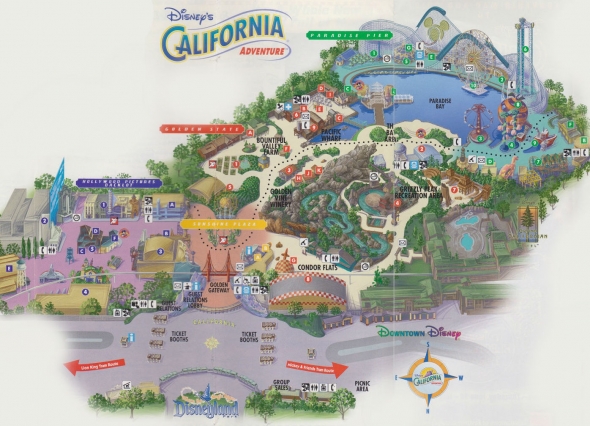
Click and expand for a larger view. Image: Disney
When California Adventure opened, it had only four theme lands (here called “districts”) – Sunshine Plaza, Hollywood Pictures Backlot, The Golden State, and Paradise Pier. All four were plagued by the park’s foundational folly: rather than being romanticized, idealized visions of a historic California transporting us to a time and place we've always imagined (think of Disneyland's Adventureland, Frontierland, Fantasyland, New Orleans Square, etc), California Adventure's districts were unabashedly modern. Each was set in the present and packed with modern allusions, puns, and jabs at Californian culture, all to the tune of modern pop music. Lightly dressed and packed with off-the-shelf thrill rides lacking Disney's storytelling and detail, the early park's harshest critics called these districts soulless, cheap, and notably short on attractions.
Take the Golden State. This all-encompassing district was actually made of no less than six sub-areas, each a miniscule parcel of land representing a corner of California. They included Pacific Wharf, the Golden Vine Winery, Bountiful Valley Farm, and The Bay Area. (Worth noting: between these four lightly themed sub-areas, there were zero rides. Zero.)
Image: Disney
Our story today deals with the other two sub-areas under the Golden State banner: Condor Flats and Grizzly Peak Recreation Area. Even with one ride each, these two sub-areas actually represented some of the best theming California Adventure had to offer in its earliest years. And at first, the notion of Grizzly Peak, for example, is lovely – a forested, High Sierras National Park. Disney Parks fans at once lit up with dreams of what such a gorgeous land could look like. Imagine it: set in the 1950s, with wooden fixtures, fire lookout towers, boulders, park rangers, towering pines...
The story and setting of Grizzly Peak practically wrote themselves. But rather than leaving well enough alone, the park's designers dialed up the "MTV attitude" and cast us not as visitors stepping back into the wild beauty of a 1950s National Park, but as extreme sports enthusiasts visiting a new white water rafting challenge, with a daredevil sports group taking over the old, rusted bones of a long-forgotten logging operation. The time is now. The place is here. Who wants to be transported to California's romantic history? Why would we care to travel back in time to see an idealized National Park? Instead, make it edgy and hip!
Likewise, the adjacent Condor Flats left California's aviation history in the dust. The sub-area was meant to resemble an airfield landing strip populated by massive rocket engines, rusted aviation apparatuses, and used up plane hangars set in an expansive and dusty desert. The effect was more or less lost, given that the tiny sub-area nestled into the forested base of Grizzly Peak couldn’t come across as a remote desert landing strip...
Image: Disney
Put simply, Condor Flats was cold and packed with iron and steel, and designers wanted it to feel barren. The land's inhabitant buildings were painted tan and wide runways funneled people straight through.
Even if Condor Flats wasn’t the most delicately themed or lovingly crafted area Imagineers had ever touched, it did contain the park’s single, solitary hit. Looming over Condor Flats was a massive, checkered airplane hangar whose halls were lined with photographs of California’s famous pilots, cementing and celebrating the state’s importance in aviation. This hangar housed California Adventure’s one home run, and evidence that the park’s foundational concept was not hopeless.
Image: Disney
What exactly awaited within California Adventure's starring E-Ticket? How was it designed? What happened to it that it's part of our Lost Legends series? We've got all the answers in this in-depth behind-the-scenes story. Read on...
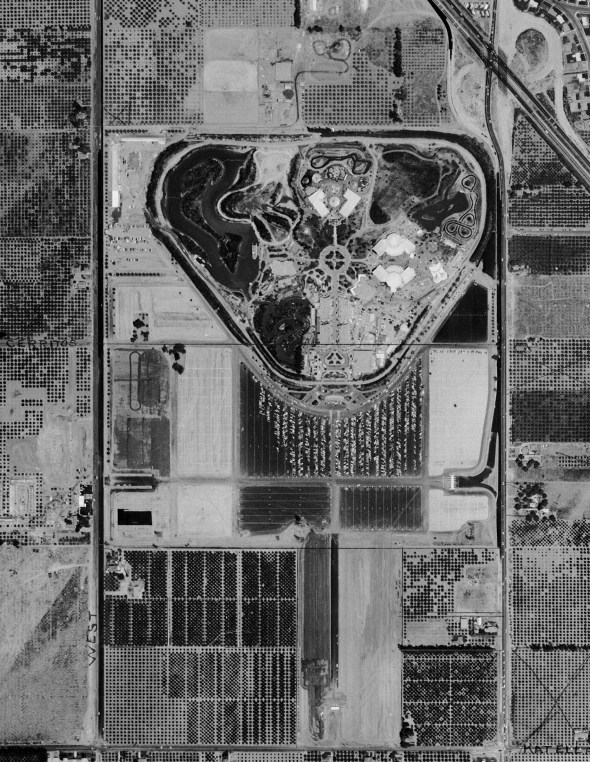
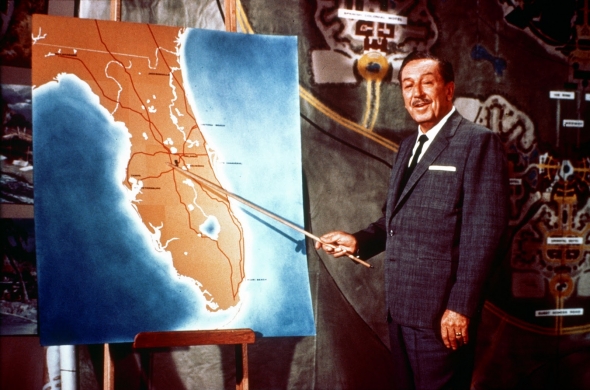
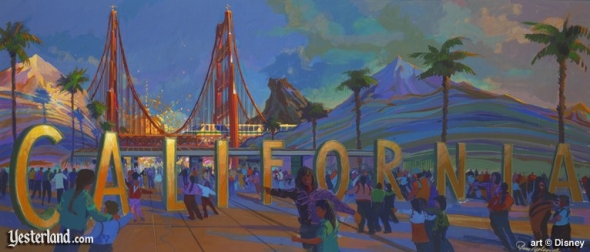
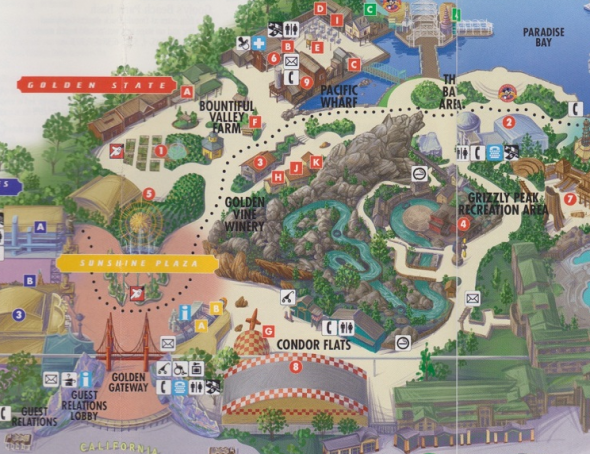
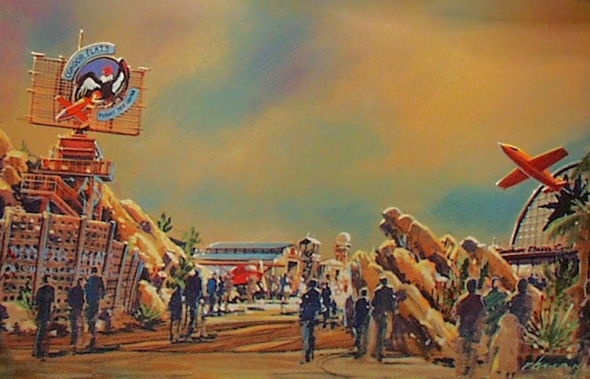


Comments
This is a good example of where I think Disney has proven to not listen to it's core fan base when it comes to theme park attractions. There is absolutely no reason that they can't at least show both films and have Soarin' be Soarin' over California and/or Soarin' around the world. I think it would be a good way to appeal to fans of both versions of the ride. And it would add rerideability to this attraction.